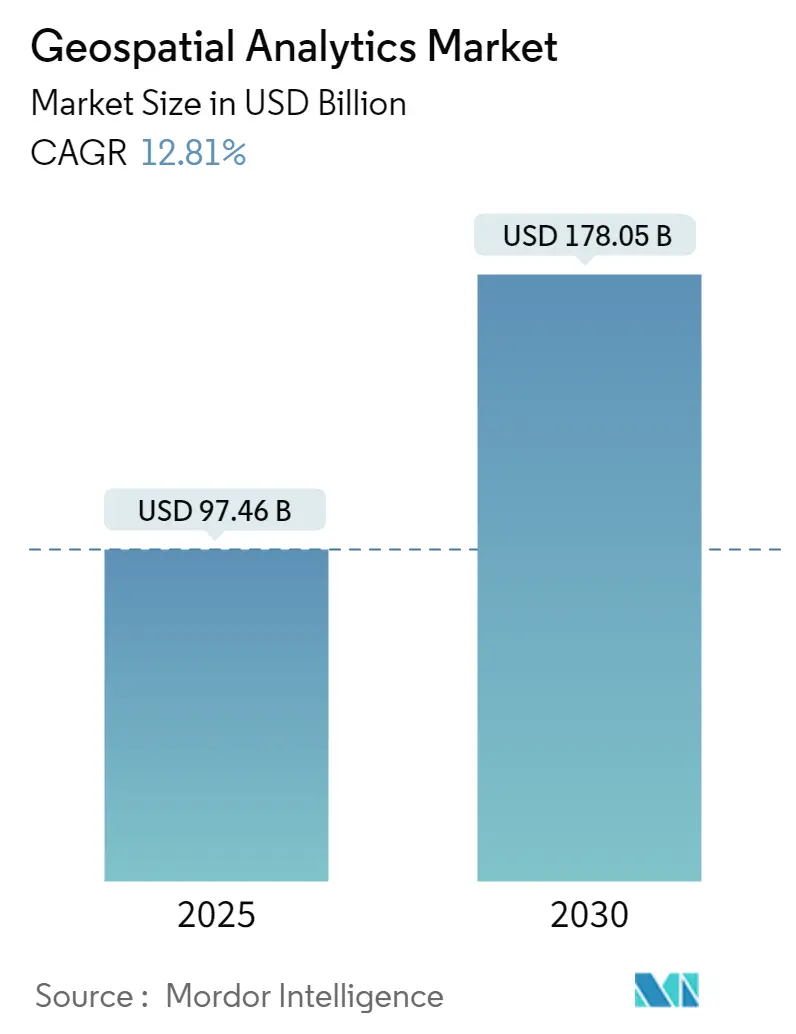
| Study Period | 2019 - 2030 |
| Market Size (2025) | USD 97.46 Billion |
| Market Size (2030) | USD 178.05 Billion |
| CAGR (2025 - 2030) | 12.81 % |
| Fastest Growing Market | Asia Pacific |
| Largest Market | North America |
| Market Concentration | High |
Major Players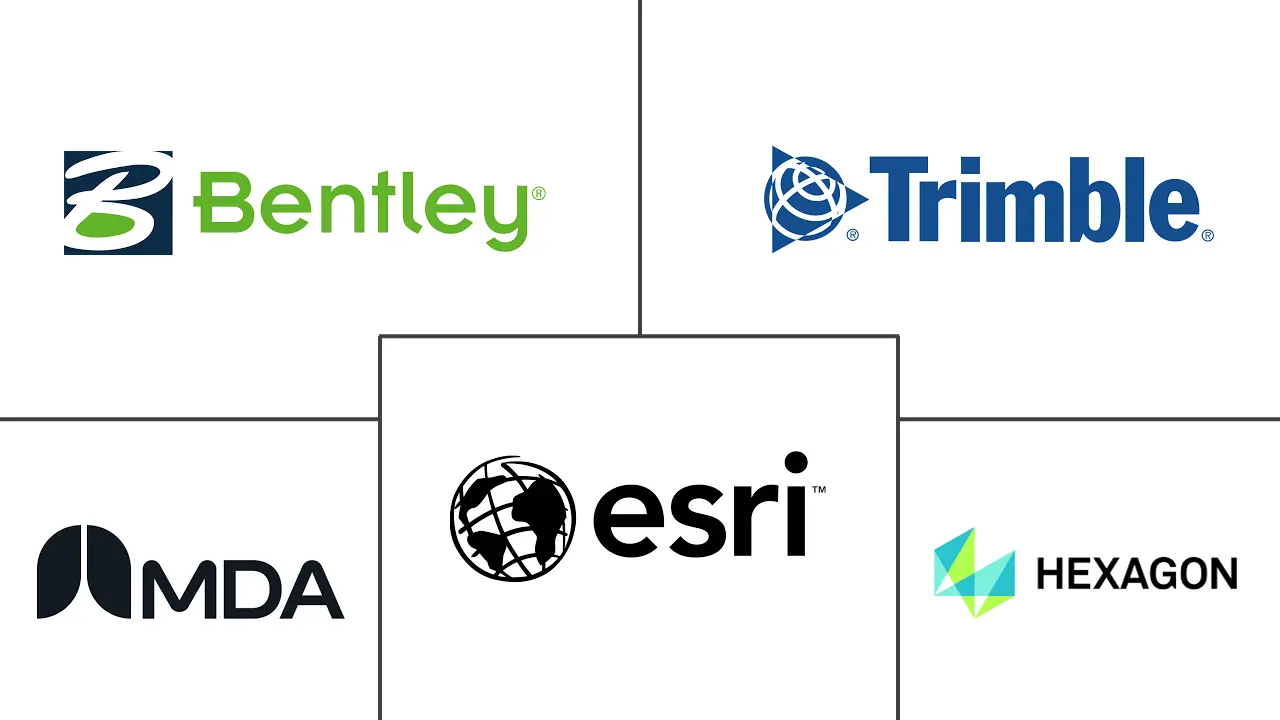
*Disclaimer: Major Players sorted in no particular order |
Geospatial Analytics Market Analysis
The Geospatial Analytics Market size is estimated at USD 97.46 billion in 2025, and is expected to reach USD 178.05 billion by 2030, at a CAGR of 12.81% during the forecast period (2025-2030).
The geospatial industry is experiencing transformative growth driven by technological convergence and increasing digitalization across sectors. The integration of advanced geospatial technology, including artificial intelligence, machine learning, big data analytics, and the Internet of Things (IoT), is revolutionizing traditional business practices through enhanced data visualization and real-time insights. According to recent projections, the number of short-range IoT devices is expected to reach 25.15 billion globally by 2027, while wide-area IoT devices are forecast to reach 5.42 billion, highlighting the expanding digital infrastructure that supports geospatial applications.
The defense and intelligence sector remains a crucial application area for geospatial data, with military organizations increasingly relying on sophisticated spatial data for strategic planning and operations. Global military spending reached USD 2.24 trillion in 2022, representing significant investment in advanced technologies, including geospatial solutions. In August 2023, IBM and Hugging Face announced a groundbreaking collaboration to make IBM's watsonx.ai geospatial foundation model, built from NASA's satellite data, openly available on Hugging Face, marking the first-ever open-source AI foundation model built in collaboration with NASA.
Natural disaster management and environmental monitoring have emerged as critical applications for geospatial technology. In 2022, there were 176 floods and 108 storms globally, making them the most common natural disasters, emphasizing the growing importance of geospatial solutions in disaster preparedness and response. The technology's application in environmental monitoring has expanded to include sophisticated planetary mapping capabilities, with organizations like the US Geological Survey's Astrogeology Science Center providing comprehensive spatial data access for celestial bodies, including Mars, Pluto, and Saturn.
The industry is witnessing significant technological advancement through strategic partnerships and innovations. In June 2023, Wherebots secured USD 5.5 million in seed funding to develop products enabling organizations to extract business value from spatial location and time data. The UAE Space Agency launched its inaugural Geospatial Analytics Platform Hackathon in 2023, demonstrating growing government support for geospatial innovation. These developments, coupled with the increasing adoption of cloud-based GIS and the integration of virtual and augmented reality technologies, are reshaping the industry landscape and creating new opportunities for market expansion.
Geospatial Analytics Market Trends
Increase in Adoption of Smart City Development
Smart city initiatives are driving unprecedented demand for geospatial analytics services, as cities worldwide embrace digital transformation to enhance urban planning and management. These solutions have evolved into essential platforms for smart city development, providing centralized information systems based on Geographic Information Systems (GIS) that support every stage of the urban development lifecycle. The technology enables comprehensive integration of various stakeholders and processes, from initial planning and design through to development and ongoing maintenance.
The integration of GIS technology has become fundamental to daily life in smart cities, facilitating everything from traffic management to utility operations. According to recent data from Italy's IoT market analysis, smart city applications witnessed significant growth from 2020 to 2022, with investments increasing from 560 million euros to 830 million euros. This technology enables city planners to create detailed urban models, manage infrastructure more efficiently, and make data-driven decisions about resource allocation. The implementation of geospatial data in smart cities has proven particularly valuable in areas such as emergency response systems, where spatial data analysis helps optimize response times and resource deployment.
Introduction of 5G to Boost Market Growth
The rollout of 5G technology is revolutionizing the geospatial analytics market by enabling the collection and processing of unprecedented volumes of geographic data. As of April 2023, 503 US cities have 5G network access, more than any other country, followed by China with 356 cities and Finland with 137 cities. This extensive 5G infrastructure provides the foundation for more sophisticated geospatial applications, particularly in millimeter wave bands that require highly accurate dense network and infrastructure data.
The integration of 5G technology with spatial data analytics is creating transformative opportunities across multiple sectors. The technology's enhanced connectivity, speed, and capacity are enabling more effective environmental monitoring and climate change management through digital mapping and location intelligence technologies. According to 5G Americas, global 5G subscriptions are projected to grow from 1.9 billion in 2023 to 5.9 billion by 2027, indicating the massive scale of potential geospatial applications. This technological convergence is particularly impactful in areas such as disaster management, where real-time data processing and analysis are crucial for effective response and mitigation strategies.
Segment Analysis: By Type
Surface Analysis Segment in Geospatial Analytics Market
Surface Analysis maintains its dominant position in the geospatial analytics market, commanding approximately 46% market share in 2024. This segment's prominence is driven by its extensive application in disaster mitigation and location planning through esoteric mapping to determine disaster probability. Surface analysis effectively utilizes general surface characteristics like slope, aspect, and curvature for analyzing variations in study objects. The segment has gained significant traction in military applications, where forces leverage it for terrain analysis, physical environment comprehension, and strategic decision-making. With advances in satellite imagery, urban development plans, and environmental monitoring, surface analysis continues to evolve rapidly. The technology's ability to address environmental challenges, optimize urban development, and facilitate informed decision-making across different sectors has further cemented its market leadership.
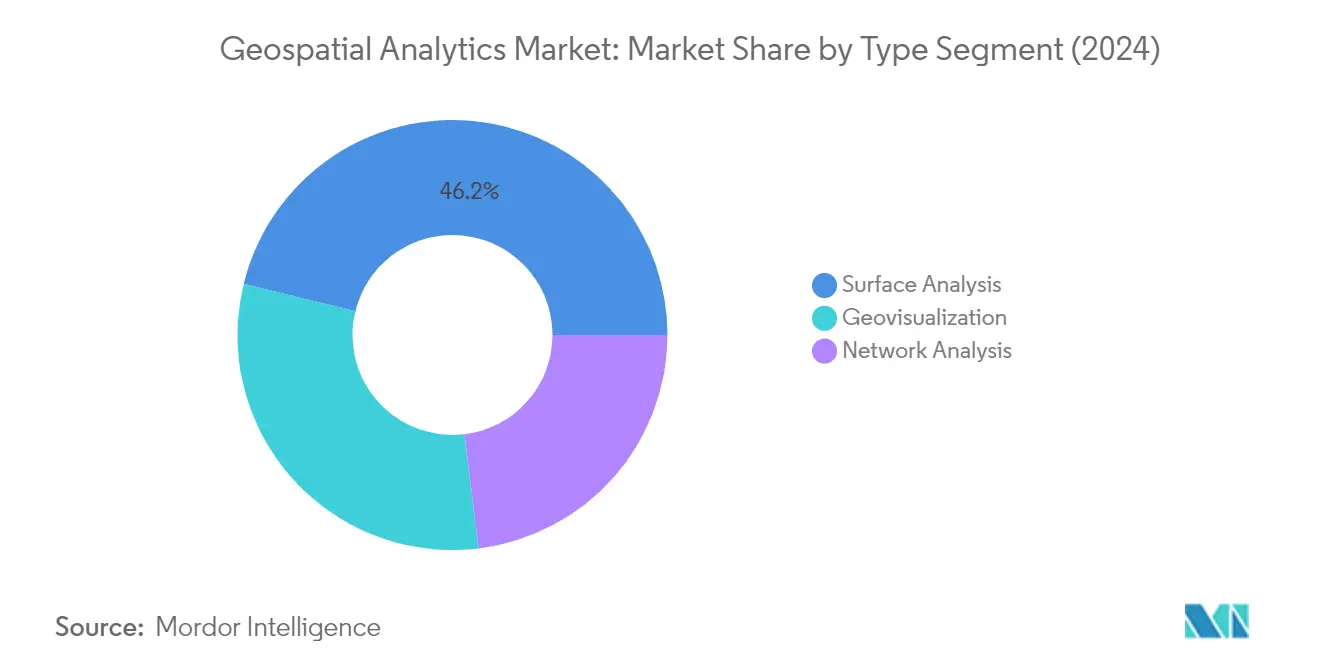
Network Analysis Segment in Geospatial Analytics Market
Network Analysis is emerging as the most dynamic segment in the geospatial analytics market, projected to grow at approximately 14% during 2024-2029. This remarkable growth is primarily attributed to its increasing significance in optimizing complex network infrastructures across various sectors. The segment's expansion is driven by its crucial role in utility companies operating in cities with complex network asset management challenges. Network analysis enables companies to efficiently design and model intricate network infrastructures for supplying electrical, telecommunications, gas, and water services to consumers using spatial data. The technology's ability to represent interconnected sets of points and lines, known as nodes and edges, makes it invaluable for modeling rivers, telecommunication lines, roads, waterlines, and highways. As cities become increasingly smart, the demand for effective network management and planning solutions continues to surge, further accelerating the segment's growth trajectory.
Remaining Segments in Geospatial Analytics Market by Type
Geovisualization represents a significant component of the geospatial analytics market, offering unique capabilities for depicting spatial data to facilitate the interpretation of observational and simulated datasets through the Earth's surface. This segment plays a crucial role in democratizing data through visual effects, helping stakeholders understand spatial data while incorporating qualitative aspects into existing spatial information. The technology finds extensive applications in urban planning, environmental studies, forestry, surveying, and climate studies. During smart city planning and construction, geographic visualization enables stakeholders to explore various real-world environments and alternative scenarios, making it an indispensable tool for modern urban development projects. Additionally, the integration of digital mapping techniques enhances the precision and utility of geovisualization efforts.
Segment Analysis: By End-User Vertical
Defense and Intelligence Segment in Geospatial Analytics Market
The Defense and Intelligence segment continues to dominate the geospatial analytics market, commanding approximately 30% market share in 2024. This segment's prominence is driven by the critical role of geospatial analytics in making geographically relevant national security decisions and military planning. The technology enables military forces to assess terrain, comprehend physical environments, and make strategic and tactical decisions. Defense organizations extensively utilize geospatial analytic tools to combine terrain data with environmental factors such as vegetation cover, wildlife population densities, and human population densities. This allows them to create detailed maps for identifying potential risks and optimizing military operations. The segment's growth is further supported by increasing defense budgets globally and the rising adoption of advanced technologies for intelligence gathering and analysis.
Agriculture Segment in Geospatial Analytics Market
The Agriculture segment is emerging as the fastest-growing sector in the geospatial analytics market, with a projected growth rate of approximately 14% during 2024-2029. This remarkable growth is driven by the increasing adoption of precision agriculture techniques and the need for optimizing crop yields through data-driven decision-making. Geospatial analytics in agriculture enables sophisticated analysis of crop development by monitoring water usage, fertilizer requirements, soil moisture content, weed growth rates, and nutrient management. The integration of artificial intelligence, machine learning, and advanced analytics with geospatial data is revolutionizing agricultural practices by enabling efficient analysis of soil conditions, weather patterns, crop life cycles, and resource management. This technological convergence is particularly evident in emerging markets where agricultural modernization initiatives are gaining momentum.
Remaining Segments in End-User Vertical
The other significant segments in the geospatial analytics market include Utility and Communication, Government, Natural Resources, and Other End-user Industries. The Utility and Communication sector leverages geospatial analytics for network planning, infrastructure management, and service optimization. The Government sector utilizes these technologies for urban planning, public safety, and service delivery optimization. The Natural Resources segment applies geospatial analytics for resource exploration, environmental monitoring, and sustainable resource management. Other end-user industries, including retail, healthcare, and transportation, are increasingly adopting geospatial analytics for location-based services and operational optimization. Each of these segments contributes uniquely to the market's growth by implementing innovative applications and solutions. The use of geospatial data for the retail industry is particularly notable as it enhances customer engagement and strategic location planning.
Geospatial Analytics Market Geography Segment Analysis
Geospatial Analytics Market in North America
North America continues to dominate the global geospatial analytics landscape, holding approximately 41% of the market share in 2024. The region's leadership position is primarily driven by the emergence of numerous startups providing specialized services, including imaging, remote sensing, location data analysis, computer vision, GIS, and drone technologies. These services are extensively utilized across various applications such as telecommunications infrastructure planning, location intelligence, and urban planning. The growth of the construction industry in the United States and Canada is particularly noteworthy, as it drives increased demand for 3D mapping and modeling capabilities. The region's strong focus on cloud-based GIS adoption and the surge in the application of VR and AR technologies in geographic information systems are creating new opportunities for market expansion. Additionally, the increasing adoption of location-tracking solutions for employee monitoring and inter-team communication management within organizations is further strengthening the market position. The region's robust technological infrastructure, combined with significant investments in research and development, continues to foster innovation in geospatial analytics solutions.
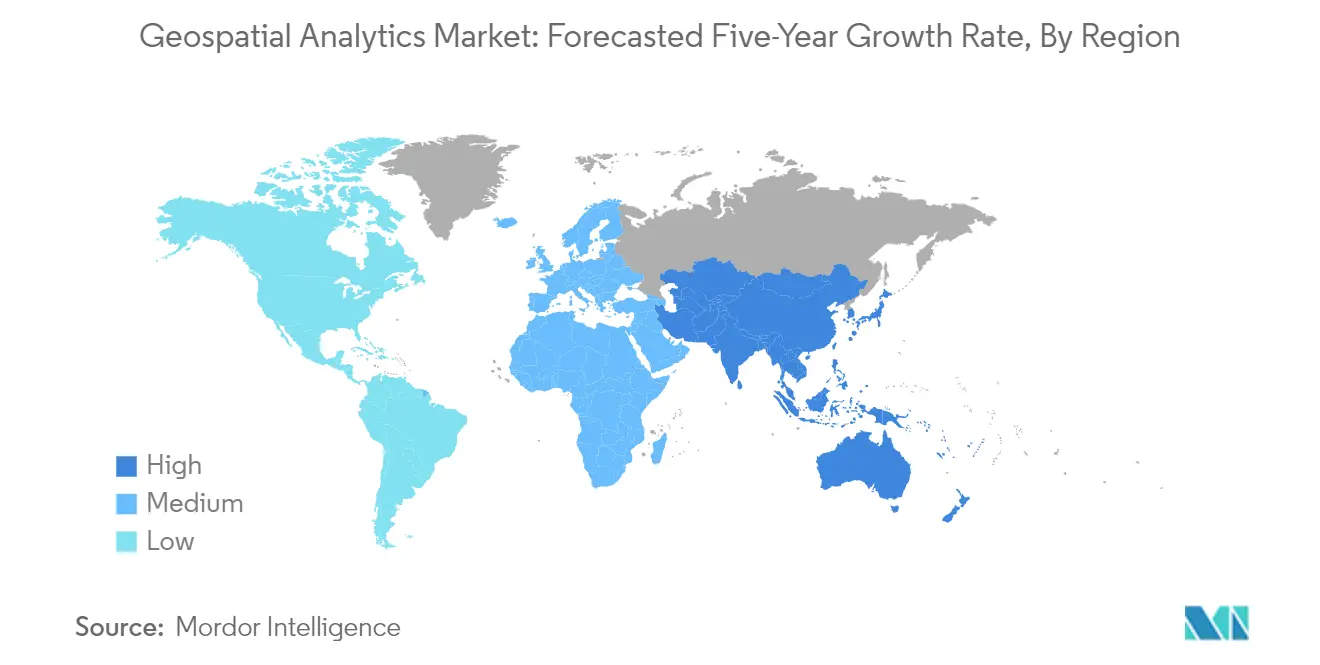
Geospatial Analytics Market in Europe
The European geospatial analytics market has demonstrated remarkable growth, experiencing an expansion of approximately 68% between 2019 and 2024. This growth trajectory is supported by ongoing technological developments in remote sensing, satellite imagery, Geographic Information Systems (GIS), and location intelligence services, which have significantly improved the quality and accessibility of geospatial data analysis across the region. European national geospatial agencies are evolving from traditional data providers to knowledge facilitators, coordinating National Digital Twin efforts through collaboration with various government agencies. The region's commitment to environmental conservation and addressing climate change has been a significant driver for geospatial analytics adoption. Many European cities are actively pursuing smart city initiatives, integrating advanced technologies to enhance citizen services, improve traffic flow, and manage energy consumption. The market's growth is further reinforced by supportive EU policies, such as the INSPIRE Directive and the EU Space Strategy, which establish a favorable environment for geospatial solutions market development and promote the standardization of geospatial data analytics sharing practices.
Geospatial Analytics Market in Asia Pacific
The Asia Pacific geospatial analytics market is positioned for substantial growth, with a projected growth rate of approximately 14% during the period 2024-2029. The region's rapid urbanization and infrastructure development serve as significant catalysts for market expansion. The increasing adoption of location analytics, driven by the surge in smartphone usage, mobile applications, and e-commerce platforms, is creating new opportunities for geospatial data analysis applications. The region's critical need for effective disaster management and resilience solutions is driving innovation in geospatial technologies. Smart city initiatives across major metropolitan areas are fostering the integration of geospatial analytics for urban planning and management. The agricultural sector, being a primary source of income for a substantial portion of the population, is increasingly leveraging geospatial solutions for improved productivity and sustainability. Government initiatives and partnerships in countries like Singapore, Australia, and India are further accelerating the adoption of geospatial technologies across various sectors.
Geospatial Analytics Market in Latin America
The Latin American geospatial analytics market is experiencing significant transformation driven by the region's unique geographical challenges and development needs. As one of the most disaster-prone regions globally, Latin America is increasingly leveraging geospatial intelligence for disaster preparedness and response management. The region's rapid urbanization is creating opportunities for spatial analytics in urban planning, transportation management, and infrastructure development. Environmental monitoring and natural resource management are becoming key application areas, with governments and organizations utilizing geospatial technologies for sustainable development initiatives. The agricultural sector is witnessing increased adoption of geospatial analytics for precision farming and crop management. Regional players are focusing on developing localized solutions that address specific challenges while maintaining international standards. The market is also seeing growing interest in defense and intelligence applications, with various countries investing in geospatial capabilities for security and surveillance purposes.
Geospatial Analytics Market in Middle East and Africa
The Middle East and Africa region presents unique opportunities for geospatial analytics applications, particularly in natural resource management and urban development. The region's rich natural resources, including oil, gas, minerals, and water, create substantial demand for geospatial solutions in resource exploration and management. Smart city initiatives, particularly in the Gulf Cooperation Council (GCC) countries, are driving the adoption of advanced geospatial technologies for urban planning and infrastructure development. The region's focus on environmental monitoring and climate change mitigation is creating new applications for geospatial analytics. Defense and security applications remain significant drivers of market growth, with governments investing in geospatial intelligence capabilities. The agricultural sector is increasingly adopting geospatial solutions for improved crop management and water conservation. Regional organizations are developing partnerships with global technology providers to enhance local capabilities and create solutions tailored to regional requirements.
Geospatial Analytics Market Overview
Top Companies in Geospatial Analytics Market
The leading geospatial companies in the geospatial analytics market include prominent players like ESRI Inc., MDA Ltd., Hexagon AB, Trimble Inc., Bentley Systems, Fugro NV, L3Harris Technologies, Atkins PLC, General Electric, and Intermap Technologies. These geospatial companies are driving innovation through advanced technologies like artificial intelligence, machine learning, and cloud computing to enhance their geospatial solutions. Market leaders are focusing on developing comprehensive platforms that integrate multiple functionalities, from data collection to advanced analytics and visualization. Strategic partnerships with technology providers and industry specialists have become increasingly common to expand solution capabilities and market reach. Companies are also investing heavily in research and development to create more sophisticated analytical tools and improve data processing capabilities. The market is witnessing a strong trend toward developing specialized solutions for specific industries like agriculture, defense, and urban planning, while simultaneously expanding geographical presence through strategic acquisitions and partnerships.
Dynamic Market Structure Drives Industry Evolution
The geospatial analytics market exhibits a moderately consolidated structure, dominated by established global players with extensive technological capabilities and comprehensive solution portfolios. These major geospatial vendors leverage their strong financial positions and technological expertise to maintain market leadership through continuous innovation and strategic acquisitions. Regional players maintain a significant presence in specific geographical areas by offering specialized solutions tailored to local market needs and maintaining strong relationships with government bodies and local enterprises. The market has witnessed numerous strategic mergers and acquisitions aimed at expanding technological capabilities, enhancing product portfolios, and strengthening geographical presence.
The competitive landscape is characterized by a mix of large conglomerates offering diverse technology solutions and specialized firms focusing exclusively on geospatial analytics. Market consolidation is primarily driven by larger players acquiring smaller, innovative companies to access new technologies and expand their market reach. Companies are increasingly focusing on developing integrated solutions that combine traditional geospatial capabilities with emerging technologies like artificial intelligence and machine learning. The industry is seeing a gradual shift from standalone products to comprehensive platform-based solutions that can address multiple industry needs while providing seamless integration with existing enterprise systems.
Innovation and Adaptability Drive Market Success
Success in the geospatial analytics market increasingly depends on companies' ability to innovate and adapt to rapidly evolving technological landscapes and customer needs. Incumbent players must focus on continuous product innovation, strategic partnerships with technology providers, and expansion into emerging markets to maintain their market position. Companies need to develop solutions that can seamlessly integrate with existing enterprise systems while offering advanced analytical capabilities and improved user experiences. The ability to provide industry-specific solutions while maintaining flexibility for customization has become crucial for market success. Companies must also invest in building strong service and support networks to ensure customer satisfaction and loyalty.
For new entrants and smaller players, success lies in identifying and focusing on specific market niches or geographical regions where they can build strong competitive advantages. Companies need to develop innovative solutions that address specific industry challenges while maintaining competitive pricing strategies. The market presents significant opportunities for players who can effectively leverage emerging technologies to create differentiated offerings. However, companies must carefully navigate regulatory requirements, particularly in sectors like defense and government services, while ensuring data privacy and security compliance. Building strong relationships with end-users and understanding their specific needs remains crucial for long-term success in this dynamic market.
Geospatial Analytics Market Leaders
-
ESRI Inc.
-
MDA LTD.
-
Hexagon AB
-
TRIMBLE INC.
-
Bentley Systems, Inc.
- *Disclaimer: Major Players sorted in no particular order
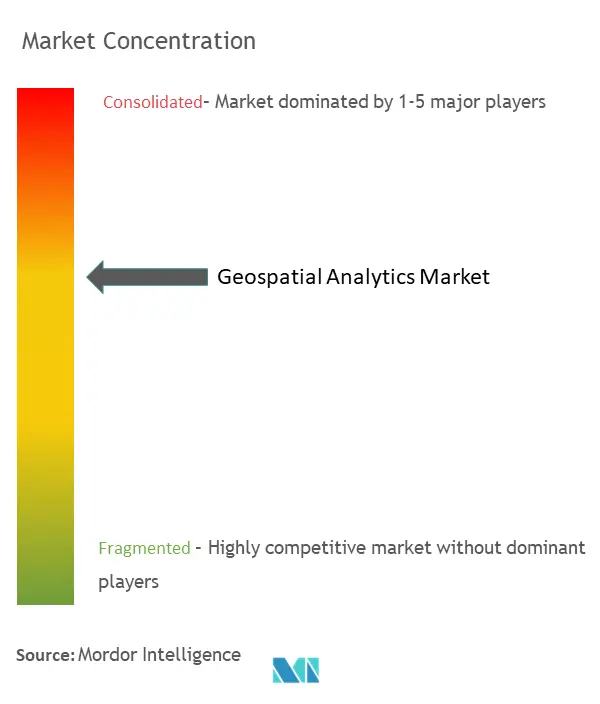
Geospatial Analytics Market News
- June 2023: Intermap Technologies leveraged its high-resolution elevation data access to perform imagery correction services for a national government organization to support the development projects in El Salvador and Honduras in Central America. In partnership with GeoSolutions, Intermap enables the creation of precision maps that are invaluable resources in supporting community safety and resiliency.
- March 2023: Mach9, the company building the fastest technologies for geospatial production, introduced its first product. The new product leverages computer vision and AI to produce faster 2D and 3D CAD and GIS engineering deliverables. This product launch comes amidst Mach9's pivot to a software-first business model, which is a move that is primarily driven by the rising demand for tools that accelerate geospatial data processing and analysis for infrastructure management.
Geospatial Analytics Market Report - Table of Contents
1. INTRODUCTION
- 1.1 Study Assumptions and Market Definition
- 1.2 Scope of the Study
2. RESEARCH METHODOLOGY
3. EXECUTIVE SUMMARY
4. MARKET INSIGHTS
- 4.1 Market Overview
- 4.2 Industry Value Chain Analysis
-
4.3 Industry Attractiveness - Porter's Five Forces Analysis
- 4.3.1 Threat of New Entrants
- 4.3.2 Bargaining Power of Buyers/Consumers
- 4.3.3 Bargaining Power of Suppliers
- 4.3.4 Threat of Substitute Products
- 4.3.5 Intensity of Competitive Rivalry
5. MARKET DYNAMICS
-
5.1 Market Drivers
- 5.1.1 Increase in Adoption of Smart City Development
- 5.1.2 Introduction of 5G to Boost Market Growth
-
5.2 Market Challenges
- 5.2.1 High Costs and Operational Concerns
- 5.2.2 Legal Hurdles
- 5.3 Assessment of Impact of COVID-19 on Geospatial Analytics Market
6. MARKET SEGMENTATION
-
6.1 By Type
- 6.1.1 Surface Analysis
- 6.1.2 Network Analysis
- 6.1.3 Geovisualization Analysis
-
6.2 By End-user Vertical
- 6.2.1 Agriculture
- 6.2.2 Utility and Communication
- 6.2.3 Defense and Intelligence
- 6.2.4 Government
- 6.2.5 Natural Resources
- 6.2.6 Other End-user Verticals
-
6.3 By Geography***
- 6.3.1 North America
- 6.3.2 Europe
- 6.3.3 Asia
- 6.3.4 Australia and New Zealand
- 6.3.5 Latin America
- 6.3.6 Middle East and Africa
7. COMPETITIVE LANDSCAPE
-
7.1 Company Profiles*
- 7.1.1 ESRI Inc.
- 7.1.2 MDA LTD.
- 7.1.3 Hexagon AB
- 7.1.4 TRIMBLE INC.
- 7.1.5 Bentley Systems, Inc.
- 7.1.6 Fugro NV
- 7.1.7 L3harris Technologies, Inc.
- 7.1.8 ATKINS PLC (SNC LAVLIN GROUP)
- 7.1.9 General Electric (GE)
- 7.1.10 Critigen LLC (Locana Formerly CRITIGEN)
- 7.1.11 Intermap Technologies Inc.
8. INVESTMENT ANALYSIS
9. MARKET OPPORTUNITIES AND FUTURE TRENDS
Geospatial Analytics Market Industry Segmentation
Geospatial analysis uses the data to build infrastructure, graphs and blueprints, statistics, and cartograms, making complex relationships understandable by collecting information, displaying images, geographical coordinates, etc. It monitors the climate and weather, helps retail stores plan their logistics transportation and human population forecasting, and many other solutions depending on the industry.
The geospatial analytics market is segmented by type (surface analysis, network analysis, and geo-visualization), end-user industry (agriculture, utility and communication, defense and intelligence, government, natural resources, and other end-user industries), and geography (North America, Europe, Asia Pacific, Latin America, and Middle East and Africa). The market sizes and forecasts are provided in terms of value (USD) for all the above segments.
| By Type | Surface Analysis |
| Network Analysis | |
| Geovisualization Analysis | |
| By End-user Vertical | Agriculture |
| Utility and Communication | |
| Defense and Intelligence | |
| Government | |
| Natural Resources | |
| Other End-user Verticals | |
| By Geography*** | North America |
| Europe | |
| Asia | |
| Australia and New Zealand | |
| Latin America | |
| Middle East and Africa |
Geospatial Analytics Market Research FAQs
How big is the Geospatial Analytics Market?
The Geospatial Analytics Market size is expected to reach USD 97.46 billion in 2025 and grow at a CAGR of 12.81% to reach USD 178.05 billion by 2030.
What is the current Geospatial Analytics Market size?
In 2025, the Geospatial Analytics Market size is expected to reach USD 97.46 billion.
Who are the key players in Geospatial Analytics Market?
ESRI Inc., MDA LTD., Hexagon AB, TRIMBLE INC. and Bentley Systems, Inc. are the major companies operating in the Geospatial Analytics Market.
Which is the fastest growing region in Geospatial Analytics Market?
Asia Pacific is estimated to grow at the highest CAGR over the forecast period (2025-2030).
Which region has the biggest share in Geospatial Analytics Market?
In 2025, the North America accounts for the largest market share in Geospatial Analytics Market.
What years does this Geospatial Analytics Market cover, and what was the market size in 2024?
In 2024, the Geospatial Analytics Market size was estimated at USD 84.98 billion. The report covers the Geospatial Analytics Market historical market size for years: 2019, 2020, 2021, 2022, 2023 and 2024. The report also forecasts the Geospatial Analytics Market size for years: 2025, 2026, 2027, 2028, 2029 and 2030.
Our Best Selling Reports
Geospatial Analytics Market Research
Mordor Intelligence provides comprehensive industry analysis and market outlook for the geospatial analytics market, covering vital aspects like market size, growth projections, and competitive landscape of leading geospatial companies. Our research encompasses emerging trends in geospatial technology, location intelligence, and spatial computing, delivering actionable insights through detailed market segmentation and industry statistics. The report pdf includes in-depth analysis of key market segments including geographic information systems, spatial data analytics, and geodata analytics, helping stakeholders make informed decisions about market opportunities and challenges.
Our consulting expertise extends beyond traditional market research to provide strategic insights for the geospatial industry. We offer technology scouting services to identify cutting-edge developments in geospatial intelligence and digital mapping solutions, along with comprehensive competition assessment of geospatial analytics companies. Our team conducts detailed analysis of customer needs and behavior patterns in various applications of spatial analytics, supporting businesses with go-to-market strategies and product positioning. We also provide partner identification and assessment services, helping companies build strong networks within the geospatial solutions market, while our project feasibility analysis ensures successful implementation of new geospatial initiatives.




